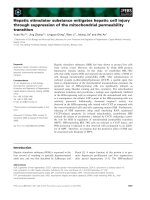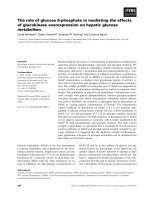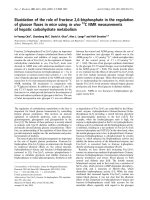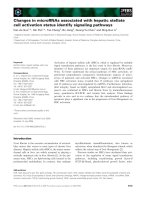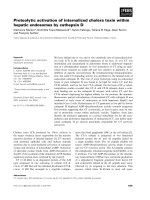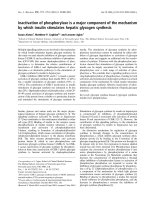HEPATIC HEMANGIOMAS
Bạn đang xem bản rút gọn của tài liệu. Xem và tải ngay bản đầy đủ của tài liệu tại đây (2.18 MB, 25 trang )
Dept.. of Cardiology Department, Children 2 Hospital
Dept
INTRODUCTION
BACKGROUND
• Infantile hemangiomas affect 4-5% of white infants, mostly cutaneous
• Hepatic hemangiomas is the most common benign liver neoplasm in infants
PRESENTATION
• Wide range – most are asymptomatic
• High output heart failure due to arteriovenous shunting
• Hypothyroidism: overproduction of iodothyronine deiodinase
• Kasabach-Merritt Syndrome: thrombocytopenia and coagulopathy
DIAGNOSTIC IMAGING
• Utrasonographic, CT or MRI
TYPE
• Focal, muti-focal and diffuse
CLINICAL SYMPTOMS
DIAGNOSTIC IMAGING
Adriana Toro. Concise review in indications and treatment of hepatic
hamangiomas. Annal of Hepatology, 2014 .
DIAGNOSTIC IMAGING
TYPES OF HEPATIC HEMANGIOMA
FOCAL
MULTIFOCAL
• Rarely associated
with cutaneous
hemangiomas
• GLUT1 negative
• Often detected on
screening due to
multiple cutaneous
hemangiomas
• GLUT1 positive
DIFFUSE
• Association with high
output cardiac failure
• More serious course
• GLUT1 positive
Hepatic Hemangioma: Types
Belinda D, Roshni D. Jounal of Pediatric Surgery, 2009
THERAPEUTIC OPTIONS
MEDICAL THERAPY
High dose corticosteroids
Until recently was the main stay of therapy
Exact mechanism unknown (possible mechanism includes
inhibition of VEGF –A)
Causes slowing and stabilization of progression but not
involution
Only 30-60% respond clinically to steroids
Adverse effects: growth retardation, adrenal suppression,
hypertension, insomnia, immunosuppression
THERAPEUTIC OPTIONS
MEDICAL THERAPY
Interferon -alpha
Second line option (usually reserved for steroid –
nonresponsive)
Unknown mechanism
May cause up to 50% regression
Adverse effects: risk of spastic diplegia, may have
rebound growth with discontinuation of therapy
THERAPEUTIC OPTIONS
PROPRANOLOL
THERAPEUTIC OPTIONS
PROPRANOLOL
Found to treat cutaneous hemangioma incidentally in 2008
and no RCT assessing use in cutaneous or hepatis
hemangioma
Mechanism: decreased renin production causing
decreased VEGF and vasoconstriction
Can cause involution of hemangioma, mean response
98% (all locations)
Adverse effects: hypotension, hypoglycemia, wheezing or
bronchoconstriction, insomnia, nightmares
PROPRANOLOL FOR HEPATIC HEMANGIOMA
Authors
Dat
e
Number/
Type of
cases
MazereeuwHautier et al
(J of
Pediatrics)
201
0
Sarialioglu et
al
(Ped Blood
Cancer)
201
0
1 diffuse
(hemangioen
do-thelioma)
4 months
Morais et al
(Cutan Ocul
Toxicol)
201
0
1 Focal
2 months
Mhanna et al
(Ped
Dermatology
)
201
1
1 diffuse
2 multifocal
Sciveres et al
(JPGN)
201
1
1 multifocal
Tan et al
(Pediatrics)
201
0
1 diffuse
Bosemani et
al (Eur J
Pediatr)
201
2
1 multifocal
Avagyan et
al
(JPGN)
201
3
4 multifocal
4 diffuse
Age at
diagnos
is
0.5 – 10
months
Presentation
Heart failure (3)
Hypothyroidism (3)
Dose/
Duration
2-3.5
mg/kg/d
Outcomes
Undetectable (3)
> 50% reduction (5)
0.5 - 10 mo
3 - 8 wks
3 months
3 wks
Respiratory distress
Cutaneous hemangiomas
2.5 mg/kg/d
Cutaneous hemangiomas
Parotid hemangiomas
2mg/kg/d
Cutaneous hemangiomas
(3)
Hypothyroidism (2)
Heart Failure (2)
1.5-2
mg/kg/d
Cutaneous hemangiomas
Heart Failure
1-2 mg/kg/d
Cutaneous hemangiomas
1.5 mg/kg/d
2.5 mo
16 mo
4 - 17 mo
(ongoing)
14 m
(ongoing)
12 mo
15 wks
Heart Failure
Cutaneous hemangiomas
0.5 – 2
mg/kg/d
30 wks
1 diffuse
(hemangioen
do-thelioma)
2 wks
Cutaneous hemangiomas
Hypothyroidism
0.25-2
mg/kg/d
12 mo
Decrease in size and number of
hepatic lesions, partial resolution of
cutaneous lesions
Complete resolution of all
hemangiomas
Partial response hepatic lesions (2)
Resolution of hepatic lesions (1)
Heart failure resolved (2)
Hypothyroidism resolved (2)
Dramatic reduction at 3 months
Complete resolution at 14 months
Heart failure resolved after 4 weeks
Near complete resolution of hepatic
lesions at 4 months
Near complete resolution of hepatic
lesions
Resolution of heart failure
Significant regression of all lesions at
3months
Resolution of all but 1 hepatic lesions
by 14 mo
Hypothryoidism resolved
PROPRANOLOL FOR
HEPATIC HEMANGIOMAS
8 reports from 2010-2014
PATIENTS
17 pts age 2wks-10months
8 diffuse hemangioma, 8 multifocal hemangioma, 1 focal hemangioma
8 with heart failure, 6 with hypothyroidism, All had cutaneous hemangiomas
TREATMENT
Dose: 0.25 – 2 mg/kg/d
Duration: 2.5- 17 months (some still ongoing)
OUTCOMES
All showed decrease in hemangioma size
6 showed complete resolution
All cases of HF and hypothyroidism resolved
ADVERSE EVENTS
2 pts developed symptomatic bradycardia requiring decreased doses
No other adverse effects reported
HEPATIC ARTERY EMBOLIZATION/
SURGICAL RESECTION
Invasive treatment options should be limited to cases with significant
symptoms that are refractory to medical management as most
hemangiomas will regress
Hepatic artery embolization can lead to significant improvement in
heart failure in patients with shunting
Significant risks are present even with embolization: including
thrombosis, repeat procedures and even death
Surgical resection can be technically challenging, especially in infants
Multifocal/Diffuse lesions may not be amenable to resection and may
require transplantation
RESULTS OF THE
TREAMENTS
CASE REPORT
Male infant
Diagnosed with hepatic mass on prenatal US at 32
weeks
Delivered at 39 3/7 weeks in Tu Du hospital
Admission
well w/o respiratory support
Total enteral feeding
No cutaneous hemangiomas
Mild thrombocytopenia, normal coagulation
Thyroid function: no screening
CASE REPORT
Initial abdomen US: complex cystic/solid mass in
the right hepatic lobe measuring 41 x 36 mm
Initial Echocardiography: PFO 5mm, PDA 2mm
L-R shunt, cardiomegaly with predominant right
cardiac, Moderate TR with PAPS 40 mmHg,
normal LV size and function
CASE REPORT
Focal hepatic hemangiomas in the right hepatic lobe (53 x 54 x 50
mm)
Supply arteries arise from right hepatic artery and small branch from
abdominal aorta, then return via right superior hepatic vein
CASE REPORT
Day 13
Sign of heart failure & severe pneumonia
Management: TAE (transarterial embolization)
After TAE
Blood flow significantly, size of the hepatic
hemangiomas and the right heart ventricles.
THANK YOU FOR YOUR ATTENTION

